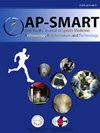计算机断层扫描成像时肢体位置对股骨颈内翻角测量的影响
IF 1.5
Q3 ORTHOPEDICS
Asia-Pacific Journal of Sport Medicine Arthroscopy Rehabilitation and Technology
Pub Date : 2025-04-01
DOI:10.1016/j.asmart.2025.04.003
引用次数: 0
摘要
背景:股骨颈前倾角已被用作髋关节和髌股关节疾病的外科指标。然而,在成像过程中,肢体位置对股骨颈前倾角测量的影响尚不清楚。因此,本研究旨在探讨肢体位置对股骨颈前倾角测量的影响。方法对10例患者的20根股骨进行计算机断层扫描。测量轴向片上穿过股骨头中心和股骨颈中心的线与股骨后髁切线之间的夹角为股骨颈前倾角。原始股骨颈前倾角数据定义为原始股骨颈前倾角。轴向平面的切割方向以5°的增量从- 20°变为20°,以模拟以下每个测量的肢体位置变化:髋关节屈伸、外展/内收角及其组合方向。测量各工况下股骨颈前倾角,计算其变化量。采用Spearman秩相关系数分析髋角与股骨颈前倾角变化的相关性。结果股骨颈前倾角平均为17.6°。髋屈伸变化与股骨颈前倾角度变化呈显著负相关(r = - 0.96, p <;0.001)。髋关节内收/外展变化与股骨颈前倾角变化相关性较弱(r = 0.35, p <;0.001)。股骨颈前倾角测量结合屈伸外展内收的平均最大电位差为21.0°±4.9°。结论股骨颈前倾角随肢体位置的变化而变化,尤其是髋屈伸。需要仔细注意肢体位置和切片条件,以一致地评估股骨颈前倾角。本文章由计算机程序翻译,如有差异,请以英文原文为准。
Influence of limb position on femoral neck anteversion angle measurement during computed tomography imaging
Background
The femoral neck anteversion angle has been used as a surgical indicator for hip and patellofemoral joint disorders. However, the influence of limb position on femoral neck anteversion angle measurements during imaging remains unclear. Therefore, this study aimed to investigate the influence of limb position on femoral neck anteversion angle measurements.
Methods
Computed tomography images of 20 femurs from 10 patients were obtained. The angle between the line passing through the center of the femoral head and the center of the femoral neck and the tangential line of the femoral posterior condyles on axial slices was measured as the femoral neck anteversion angle. Raw femoral neck anteversion angle data was defined as the original femoral neck anteversion angle. The cutting direction of the axial plane was changed from −20° to 20° in 5° increments to simulate limb position changes for each of the following measurements: hip flexion/extension, abduction/adduction angles, and their combined directions. The femoral neck anteversion angle was measured under each condition, and the change in the angle was calculated. The correlation between hip angle and femoral neck anteversion angle change was analysed by Spearman's rank correlation coefficient.
Results
The mean original femoral neck anteversion angle was 17.6°. There was a strong negative correlation between hip flexion/extension change and femoral neck anteversion angle change (r = −0.96, p < 0.001). There was a weak correlation between hip adduction/abduction change and femoral neck anteversion angle change (r = 0.35, p < 0.001). The average maximum potential difference in femoral neck anteversion angle measurement combining flexion/extension and abduction/adduction was 21.0° ± 4.9°.
Conclusions
The femoral neck anteversion angle changed in association with changes in limb position, particularly with hip flexion and extension. Careful attention to limb position and conditions of the slice is needed to consistently evaluate the femoral neck anteversion angle.
求助全文
通过发布文献求助,成功后即可免费获取论文全文。
去求助
来源期刊
CiteScore
3.80
自引率
0.00%
发文量
21
审稿时长
98 days
期刊介绍:
The Asia-Pacific Journal of Sports Medicine, Arthroscopy, Rehabilitation and Technology (AP-SMART) is the official peer-reviewed, open access journal of the Asia-Pacific Knee, Arthroscopy and Sports Medicine Society (APKASS) and the Japanese Orthopaedic Society of Knee, Arthroscopy and Sports Medicine (JOSKAS). It is published quarterly, in January, April, July and October, by Elsevier. The mission of AP-SMART is to inspire clinicians, practitioners, scientists and engineers to work towards a common goal to improve quality of life in the international community. The Journal publishes original research, reviews, editorials, perspectives, and letters to the Editor. Multidisciplinary research with collaboration amongst clinicians and scientists from different disciplines will be the trend in the coming decades. AP-SMART provides a platform for the exchange of new clinical and scientific information in the most precise and expeditious way to achieve timely dissemination of information and cross-fertilization of ideas.

 求助内容:
求助内容: 应助结果提醒方式:
应助结果提醒方式:


